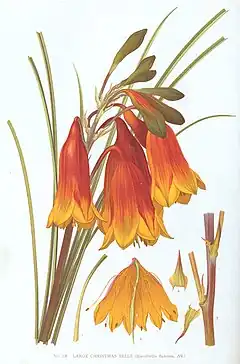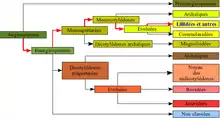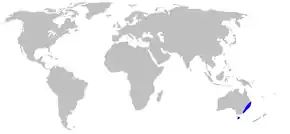Blandfordiaceae
Les Blandfordiaceae sont une famille de plantes monocotylédones qui ne comprend que 3 ou 4 espèces appartenant au genre Blandfordia.

Voir le texte pour plus d'information.

Répartition géographique

Ce sont des plantes herbacées, pérennes, généralement à rosette, tubéreuses ou à racine épaissie, aux inflorescences en racèmes. Cette famille est endémique d'Australie et de Tasmanie.
Étymologie
Le nom vient du genre Blandfordia donné en hommage au collectionneur John Spencer-Churchill (1766-1840) connu sous le nom de marquis de Blandford jusqu'en 1817[1].
Classification
Cette famille n'existe pas en classification classique de Cronquist (1981) qui assigne ces plantes aux Liliaceae.
La classification phylogénétique APG (1998)[2] a isolé cette famille et l'a rattachée à l'ordre des Asparagales.
Cette modification a été conservée en classification phylogénétique APG II (2003)[3] et classification phylogénétique APG III (2009)[4].
Liste des genres
Selon World Checklist of Selected Plant Families (WCSP) (16 avr. 2010)[5], Angiosperm Phylogeny Website (19 mai 2010)[6], NCBI (16 avr. 2010)[7] et DELTA Angio (16 avr. 2010)[8] :
- genre Blandfordia Sm. (1804)
Liste des espèces
Selon World Checklist of Selected Plant Families (WCSP) (16 avr. 2010)[5] :
- genre Blandfordia Sm. (1804)
- Blandfordia cunninghamii Lindl. (1845)
- Blandfordia grandiflora R.Br. (1810)
- Blandfordia nobilis Sm. (1804)
- Blandfordia punicea (Labill.) Sweet, Hort. Brit. (1830)
Selon NCBI (16 avr. 2010)[7] :
- genre Blandfordia
- Blandfordia grandiflora
- Blandfordia nobilis
- Blandfordia punicea
Notes et références
- (en) David Gledhil, The Names of Plants, Cambridge University press, , 426 p. (ISBN 978-0-5216-8553-5, lire en ligne), p. 72
- (en) Angiosperm Phylogeny Group, « An ordinal classification for the families of flowering plants », Annals of the Missouri Botanical Garden, Jardin botanique du Missouri, vol. 85, no 4, , p. 531–553 (ISSN 0026-6493, 2162-4372, 0893-3243 et 2326-487X, DOI 10.2307/2992015, JSTOR 2992015, lire en ligne)
- (en) Angiosperm Phylogeny Group, « An update of the Angiosperm Phylogeny Group classification for the orders and families of flowering plants: APG II », Botanical Journal of the Linnean Society, Wiley-Blackwell, Linnean Society of London et OUP, vol. 141, no 4, , p. 399–436 (ISSN 0024-4074 et 1095-8339, DOI 10.1046/J.1095-8339.2003.T01-1-00158.X)
- (en) Angiosperm Phylogeny Group, « An update of the Angiosperm Phylogeny Group classification for the orders and families of flowering plants: APG III », Botanical Journal of the Linnean Society, Wiley-Blackwell, Linnean Society of London et OUP, vol. 161, no 2, , p. 105–121 (ISSN 0024-4074 et 1095-8339, DOI 10.1111/J.1095-8339.2009.00996.X)
- WCSP. World Checklist of Selected Plant Families. Facilitated by the Royal Botanic Gardens, Kew. Published on the Internet ; http://wcsp.science.kew.org/, consulté le 16 avr. 2010
- Stevens, P. F. (2001 onwards). Angiosperm Phylogeny Website. Version 14, July 2017 [and more or less continuously updated since]." will do. http://www.mobot.org/MOBOT/research/APweb/, consulté le 19 mai 2010
- NCBI, consulté le 16 avr. 2010
- DELTA Angio, consulté le 16 avr. 2010
Liens externes
- (en) Référence Kew Garden World Checklist : Blandfordiaceae
- (en) Référence Angiosperm Phylogeny Website : Blandfordiaceae ()
- (en) Référence DELTA Angio : Blandfordiaceae Dahlgren and Clifford
- Voir aussi Liliaceae
- (en) Référence Tree of Life Web Project : Blandfordiaceae
- (en) Référence Paleobiology Database : Blandfordiaceae Dahlgren and Clifford
- (en) Référence NCBI : Blandfordiaceae (taxons inclus)
- (en) Référence GRIN : famille Blandfordiaceae R. Dahlgren et Clifford (+liste des genres contenant des synonymes)